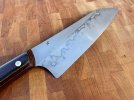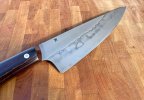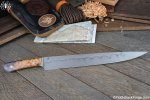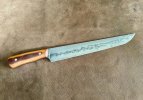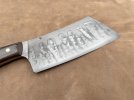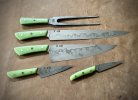Pictures really help, when you are learning and even once you get comfortable taking photos of your clay layout and then the finished hamons can be a great way to track what works and what doesn’t. As mentioned 1084 isn’t the best choice for hamons but the bigger issue in this case is the canola oil, despite it being recommended for people to start with it really isn’t fast enough for shallow hardening steels which 1084 technically is it’s just on the deeper hardening side of what are technically considered water quenching steels. For most knife blades though people opt for fast oils like parks 50 as it’s safer. For hamons you really want as fast of a quench as possible, some argue water gives the best activity but it’s definitely a learning curve to reduce the number of cracked blades you’ll get. Outside of steel choice and quench medium the next two biggest factors to address are geometry and clay application. You want to pre grind your blade to about 80% of your finished geometry, I take my edge down to .040-.050 and 90% to the finished height I want the bevel at. If you clay a blade at full thickness especially using a slow oil you will definitely run into issues and even if the edge does fully harden you’ll likely lose a lot of the hamons activity the further you grind. For your clay I try to go no thicker than 1/16” but that may vary depending on the clay you use and is something you’ll need to experiment with, if you make 3 identical blades pre grind to the same point and clay them one at 1/16” one at 1/8” and one with no clay use the same hardening process for each and see where the hamon line is in comparison to your clay line, if it’s right on your clay line or a touch lower great remember that thickness, if it’s much lower you may be insulating too much meaning too thick on the clay. The no clay sample is to give you an idea of what geometry and stock thickness will do for an auto hamon. Now on to actually heat treating, lower temps seem to give more active hamons mixed with short soak times the balance here is figuring out how short of a soak at a given temp will work, temp too low and soak too short and likely won’t harden properly, longer soak at low temp should harden properly but if you soak too long and too much heat goes to the spine you may not get as much activity. See above that ideally I want my hamon slightly below my actual clay line just barely, that is where I find with a combination of all things I get the best activity. Too hot on your hardening temp and it will likely give just a plain line or it will harden under the clay slightly (which can also be caused if your clay is too thin or flakes off because the steel wasn’t clean) hopefully this helps and shows how many variables go into a good hamon. Start with simple straight lines then move on from that in clay layout once you have a good idea of what does what.

